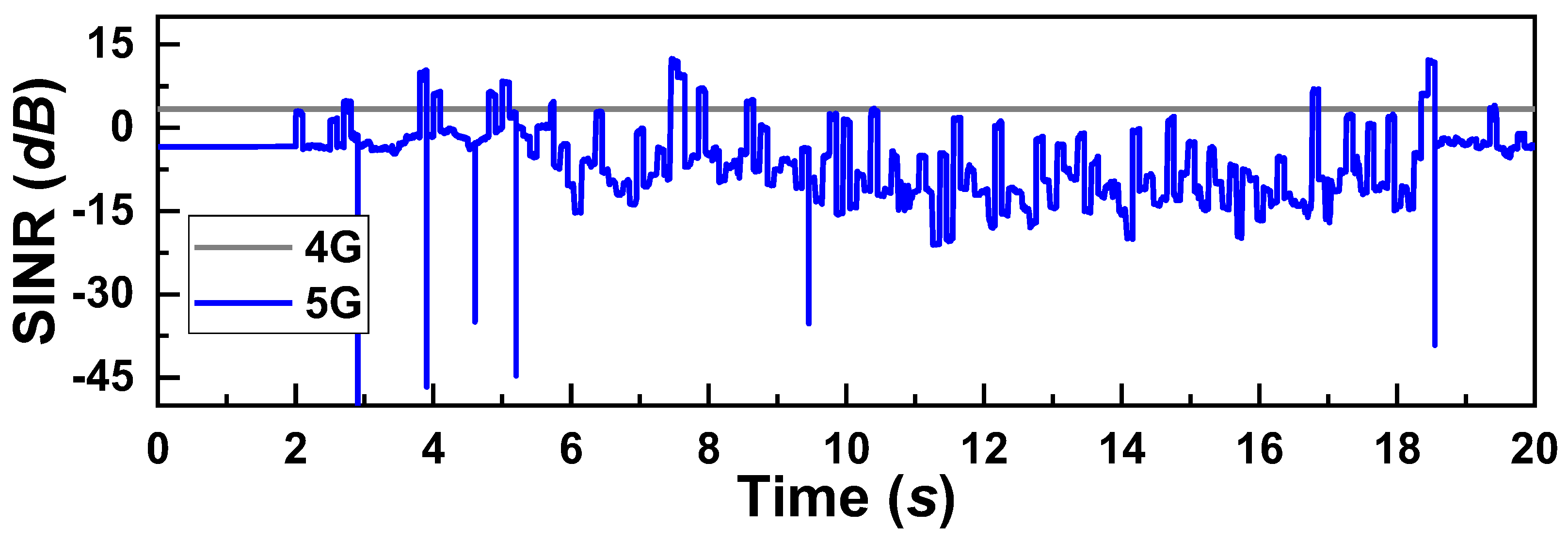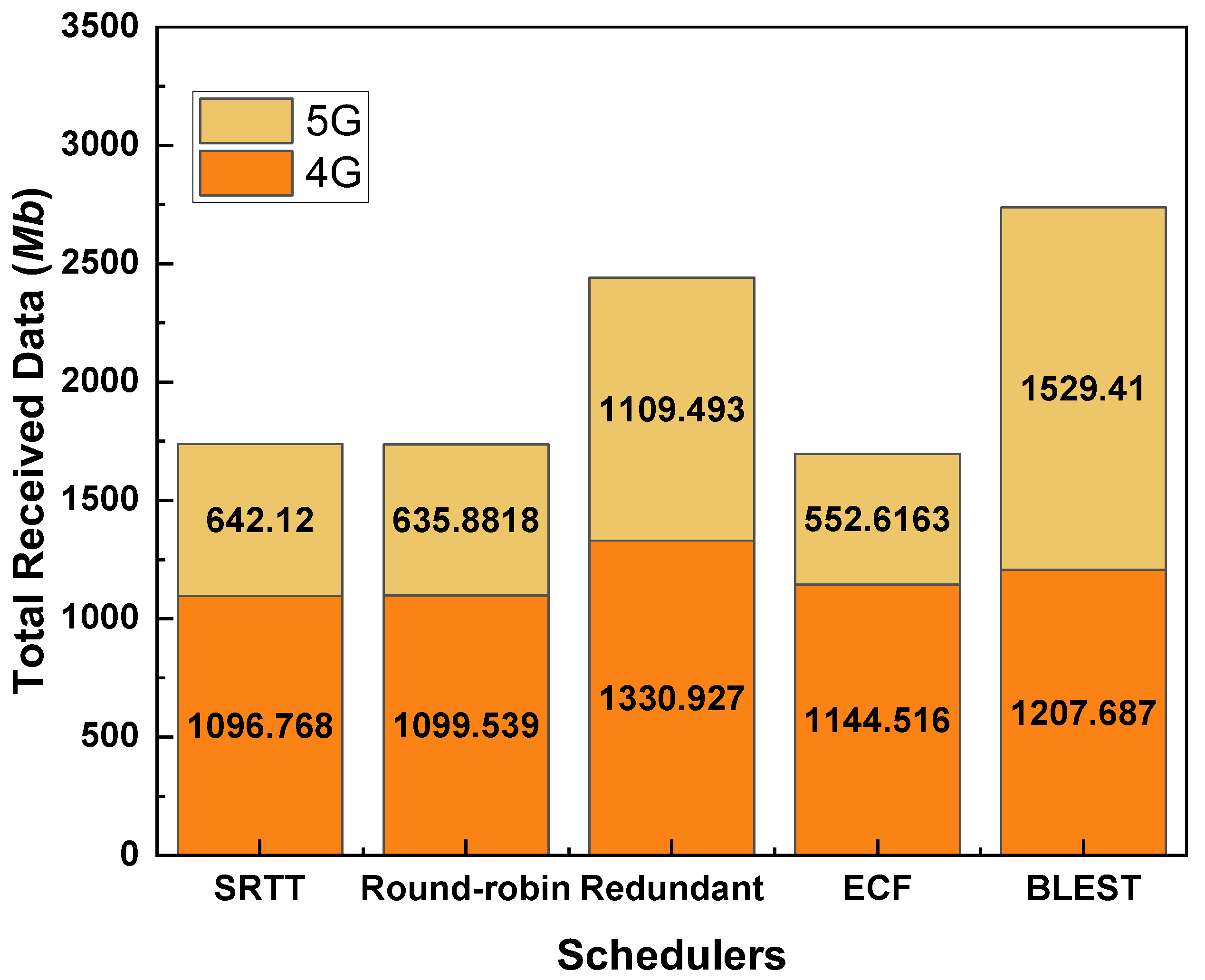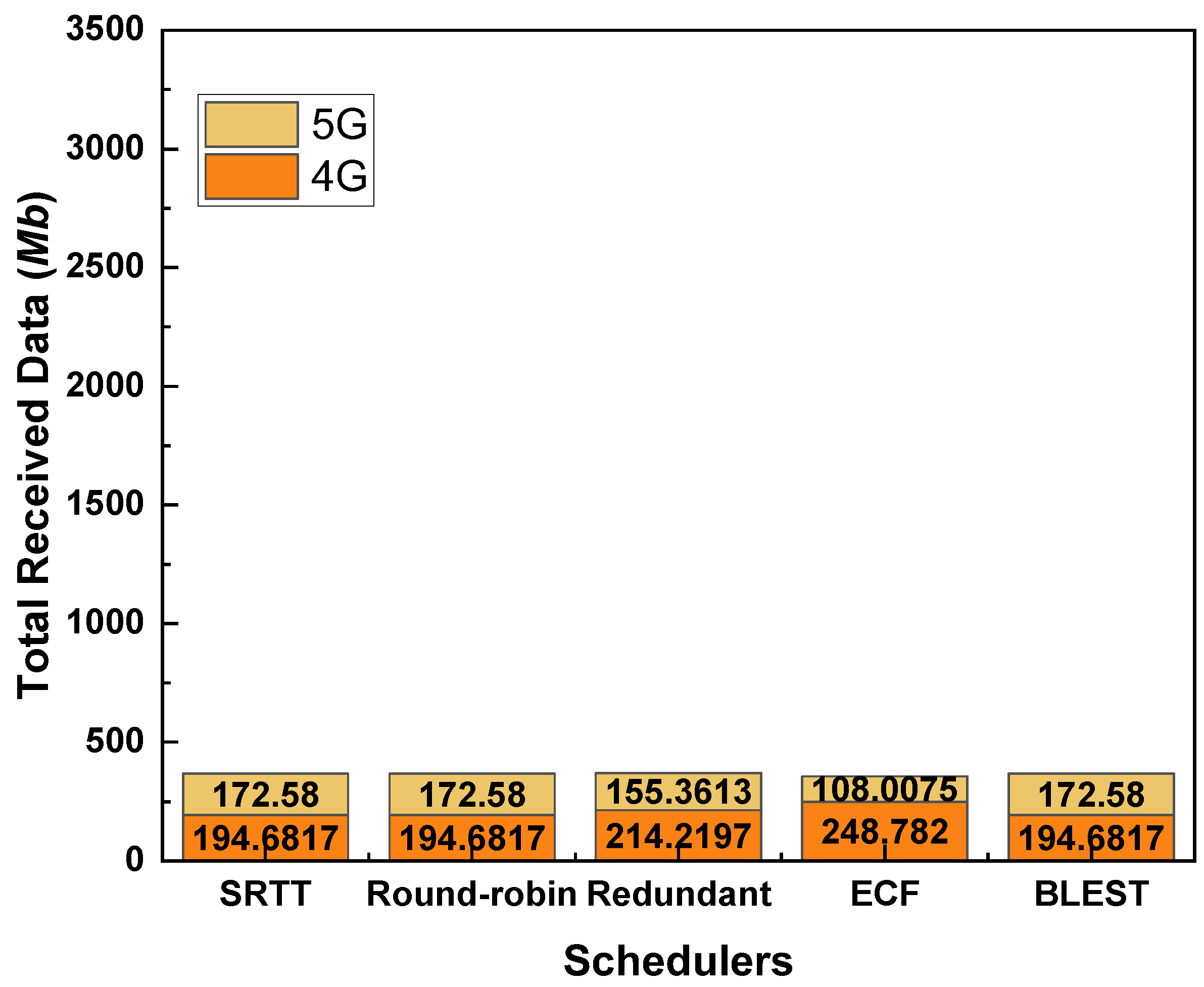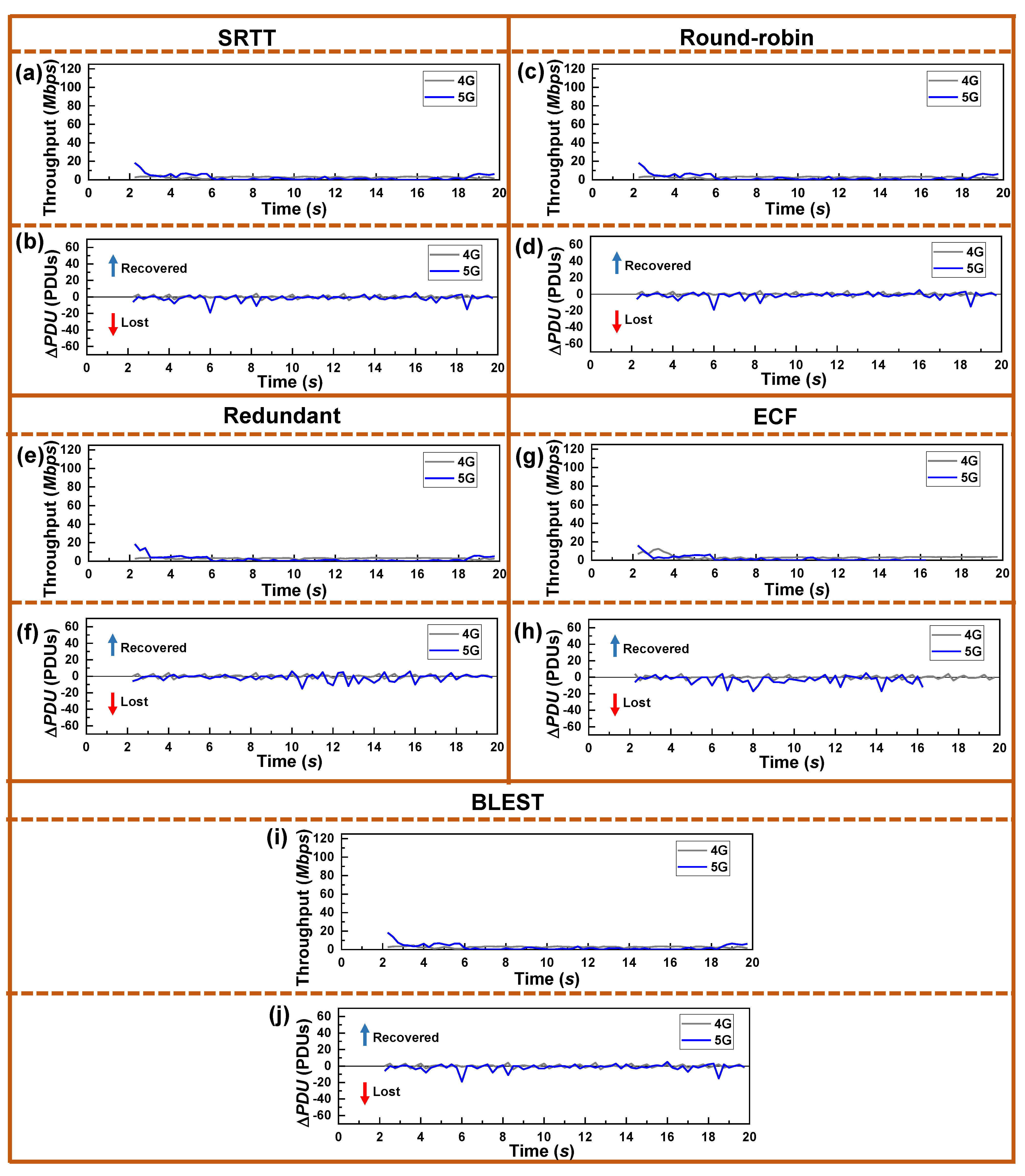Performance Evaluation of MPTCP on Simultaneous Use of 5G and 4G Networks
Abstract
1. Introduction
- We developed a simulation testbed using NS3-DCE [24] with MPTCP Linux Kernel v0.90 [25] and NS-3.33 mmWave module [26]. As a result, evaluating the performance of MPTCP on 3GPP (e.g., 5G and 4G) and non-3GPP (e.g., WiFi, WiMax, Ethernet, etc.) networks is possible. For a productive comparison, we also incorporated cutting-edge schedulers, such as redundant, earliest completion first (ECF), and blocking estimation (BLEST), in the MPTCP Linux Kernel v0.90 [25].
- We tested several MPTCP schedulers in combination with available CCAs in MPTCP Linux Kernel, compared their performance in terms of throughput and flow completion time (FCT), and outlined the best combination for real-world deployment.
- During the experiments, we also found that the signal to interference and noise ratio (SINR) directly impacts the obtained throughput of each path. Through proper investigation, we outlined the relation between SINR, throughput, congestion window (CWND), and packet losses; how they impact the performance of different MPTCP schedulers and CCAs.
2. An Overview of The MPTCP Schedulers and Congestion Control Algorithms
2.1. MPTCP Schedulers
2.1.1. Shortest RTT First
2.1.2. Round-Robin
2.1.3. Redundant
2.1.4. Earliest Completion First
2.1.5. Block Estimation
2.2. MPTCP Congestion Control Algorithms
- Goal One: MPTCP CCAs should always ensure incentives over single path TCP (SPTCP), implying that the throughput of MPTCP should be at least equal to or greater than SPTCP’s throughput traveling through the same path.
- Goal Two: When multiple MPTCP SFs go through the same bottleneck, they should combinedly occupy a capacity equal to the capacity an SPTCP occupies while going through the same bottleneck.
- Goal Three: After fulfilling the first two goals, MPTCP CCAs should try to move the traffic from the more congested path to a less congested path among the available SFs.
2.2.1. Linked Increase Algorithm
2.2.2. Opportunistic Linked Increase Algorithm
2.2.3. Balanced Linked Adaptation
2.2.4. Weighted Vegas
2.3. Existing Research on Performance Analysis of MPTCP Schedulers
3. Experimental Setup
3.1. Testbed Setup
3.2. Simulation Environment
4. Performance Evaluation
4.1. Observed SINR
4.2. Performance Evaluations of MPTCP Schedulers When the CCA Is LIA
4.3. Performance Evaluations of MPTCP Schedulers When the CCA Is OLIA
4.4. Performance Evaluations of MPTCP Schedulers When the CCA Is BALIA
4.5. Performance Evaluations of MPTCP Schedulers When the CCA Is wVegas
5. Conclusions
Author Contributions
Funding
Acknowledgments
Conflicts of Interest
References
- Barb, G.; Otesteanu, M. 4G/5G: A comparative study and overview on what to expect from 5G. In Proceedings of the 2020 43rd International Conference on Telecommunications and Signal Processing (TSP), Milan, Italy, 7–9 July 2020; pp. 37–40. [Google Scholar]
- Brito, J.M.C.; Mendes, L.L.; Gontijo, J.G.S. Brazil 6G project-an approach to build a national-wise framework for 6G networks. In Proceedings of the 2020 2nd 6G Wireless Summit (6G SUMMIT), Levi, Finland, 17–20 March 2020; pp. 1–5. [Google Scholar]
- Haile, H.; Grinnemo, K.-J.; Ferlin, S.; Hurtig, P.; Brunstrom, A. End-to-end congestion control approaches for high throughput and low delay in 4G/5G cellular networks. Comput. Netw. 2021, 186, 107692. [Google Scholar] [CrossRef]
- The 5G Economy in a Post-Covid-19 Era: The Role of 5G in a Post-Pandemic World Economy. Available online: https://www.qualcomm.com/content/dam/qcomm-martech/dm-assets/documents/qualcomm_5g_economy_in_a_post-pandemic_era_report_2020.pdf (accessed on 18 September 2022).
- Mumtaz, T.; Muhammad, S.; Aslam, M.I.; Mohammad, N. Dual connectivity-based mobility management and data split mechanism in 4G/5G cellular networks. IEEE Access 2020, 8, 86495–86509. [Google Scholar] [CrossRef]
- Zhang, M.; Polese, M.; Mezzavilla, M.; Zhu, J.; Rangan, S.; Panwar, S.; Zorzi, M. Will TCP work in mmWave 5G cellular networks? IEEE Commun. Mag. 2019, 57, 65–71. [Google Scholar] [CrossRef]
- Talukdar, A.; Cudak, M.; Ghosh, A. Handoff rates for millimeterwave 5G systems. In Proceedings of the 2014 IEEE 79th Vehicular Technology Conference (VTC Spring), Seoul, Korea, 18–21 May 2014; pp. 1–5. [Google Scholar]
- Narayanan, A.; Ramadan, E.; Carpenter, J.; Liu, Q.; Liu, Y.; Qian, F.; Zhang, Z.-L. A first look at commercial 5G performance on smartphones. In Proceedings of the Web Conference, Taipei, China, 20–24 April 2020; pp. 894–905. [Google Scholar]
- Mei, L.; Gou, J.; Cai, Y.; Cao, H.; Liu, Y. Realtime mobile bandwidth and handoff predictions in 4G/5G networks. Comput. Netw. 2022, 204, 108736. [Google Scholar] [CrossRef]
- Pieska, M.; Kassler, A. TCP performance over 5G mmWave links—Tradeoff between capacity and latency. In Proceedings of the 2017 IEEE 13th International Conference on Wireless and Mobile Computing, Networking and Communications (WiMob), Rome, Italy, 9–11 October 2017; pp. 385–394. [Google Scholar]
- Polese, M.; Mezzavilla, M.; Rangan, S.; Zorzi, M. Mobility management for TCP in mmWave networks. In Proceedings of the 1st ACM Workshop on Millimeter-Wave Networks and Sensing Systems, Snowbird, UT, USA, 16–20 October 2017; pp. 11–16. [Google Scholar]
- Polese, M.; Jana, R.; Zorzi, M. TCP and MP-TCP in 5G mmWave networks. IEEE Internet Comput. 2017, 21, 12–19. [Google Scholar] [CrossRef]
- Mezzavilla, M.; Zhang, M.; Polese, M.; Ford, R.; Dutta, S.; Rangan, S.; Zorzi, M. End-to-end simulation of 5G mmWave networks. IEEE Commun. Surv. Tutor. 2018, 20, 2237–2263. [Google Scholar] [CrossRef]
- Li, L.; Xu, K.; Wang, D.; Peng, C.; Zheng, K.; Mijumbi, R.; Xiao, Q. A longitudinal measurement study of TCP performance and behavior in 3G/4G networks over high speed rails. IEEE/ACM Trans. Netw. 2017, 25, 2195–2208. [Google Scholar] [CrossRef]
- Shi, H.; Cui, Y.; Wang, X.; Hu, Y.; Dai, M.; Wang, F.; Zheng, K. {STMS}: Improving {MPTCP} throughput under heterogeneous networks. In Proceedings of the 2018 USENIX Annual Technical Conference (USENIX ATC 18), Boston, MA, USA, 11–13 July 2018; pp. 719–730. [Google Scholar]
- Ericsson. Non-Standalone and Standalone: Two Standards-Based Paths to 5G. In Ericsson Blog; Ekström, H., Ed.; Ericsson: Stockholm, Sweden, 2019. [Google Scholar]
- Malladi, D.P. Key Breakthroughs to Drive a Fast and Smooth Transition to 5G Standalone. Available online: https://www.qualcomm.com/news/onq/2019/08/key-breakthroughs-drive-fast-and-smooth-transition-5g-standalone (accessed on 3 August 2022).
- Wu, H.; Ferlin, S.; Caso, G.; Alay, Ö.; Brunstrom, A. A Survey on Multipath Transport Protocols Towards 5G Access Traffic Steering, Switching and Splitting. IEEE Access 2021, 9, 164417–164439. [Google Scholar] [CrossRef]
- Ha, J.; Choi, Y.-I. Support of a multi-access session in 5g mobile network. In Proceedings of the 2019 25th Asia-Pacific Conference on Communications (APCC), Ho Chi Minh City, Vietnam, 6–8 November 2019; pp. 378–383. [Google Scholar]
- Ahmadi, S. 5G NR: Architecture, Technology, Implementation, and Operation of 3GPP New Radio Standards; Academic Press: Cambridge, MA, USA, 2019. [Google Scholar]
- Barré, S.; Paasch, C.; Bonaventure, O. Multipath TCP: From theory to practice. In Proceedings of the International Conference on Research in Networking, Valencia, Spain, 13 May 2011; pp. 444–457. [Google Scholar]
- Ford, A.; Raiciu, C.; Handley, M.; Barre, S.; Iyengar, J. Architectural Guidelines for Multipath TCP Development. 2070-1721. 2011. Available online: https://www.rfc-editor.org/rfc/rfc6182.html (accessed on 17 July 2022).
- Ding, L.; Tian, Y.; Liu, T.; Wei, Z.; Zhang, X. Understanding commercial 5G and its implications to (Multipath) TCP. Comput. Netw. 2021, 198, 108401. [Google Scholar] [CrossRef]
- Tazaki, H.; Uarbani, F.; Mancini, E.; Lacage, M.; Camara, D.; Turletti, T.; Dabbous, W. Direct code execution: Revisiting library os architecture for reproducible network experiments. In Proceedings of the Theninth ACM Conference on Emerging Networking Experiments and Technologies, Santa Barbara, CA, USA, 9–12 December 2013; pp. 217–228. [Google Scholar]
- Kleinrock, L. Power and deterministic rules of thumb for probabilistic problems in computer communications. In Proceedings of the ICC’79 International Conference on Communications, Boston, MA, USA, 10–14 June 1979; Volume 3, pp. 43.1.1–43.1.10. [Google Scholar]
- Floyd, S.; Henderson, T.; Gurtov, A. The NewReno Modification to TCP’s Fast Recovery Algorithm. 2070-1721. 2004. Available online: https://www.rfc-editor.org/rfc/rfc3782 (accessed on 17 July 2022).
- Arzani, B.; Gurney, A.; Cheng, S.; Guerin, R.; Loo, B.T. Impact of path characteristics and scheduling policies on MPTCP performance. In Proceedings of the 2014 28th International Conference on Advanced Information Networking and Applications Workshops, Victoria, BC, Canada, 13–16 May 2014; pp. 743–748. [Google Scholar]
- Stallings, W. Operating Systems Internals and Design Principles; Prentice-Hall, Inc.: Hoboken, NJ, USA, 1998. [Google Scholar]
- Felix, B.; Steuck, I.; Santos, A.; Secci, S.; Nogueira, M. Redundant packet scheduling by uncorrelated paths in heterogeneous wireless networks. In Proceedings of the 2018 IEEE Symposium on Computers and Communications (ISCC), Natal, Brazil, 25–28 June 2018; pp. 00498–00503. [Google Scholar]
- Lim, Y.-s.; Nahum, E.M.; Towsley, D.; Gibbens, R.J. ECF: An MPTCP path scheduler to manage heterogeneous paths. In Proceedings of the13th International Conference on Emerging Networking Experiments and Technologies, Incheon, Korea, 12–15 December 2017; pp. 147–159. [Google Scholar]
- Ferlin, S.; Alay, Ö.; Mehani, O.; Boreli, R. BLEST: Blocking estimation-based MPTCP scheduler for heterogeneous networks. In Proceedings of the 2016 IFIP Networking Conference (IFIP Networking) and Workshops, Vienna, Austria, 17–19 May 2016; pp. 431–439. [Google Scholar]
- Raiciu, C.; Handley, M.; Wischik, D. Coupled Congestion Control for Multipath Transport Protocols. RFC-6356 IETF. 2011. Available online: https://www.rfc-editor.org/rfc/rfc6356.html (accessed on 17 July 2022).
- Raiciu, C.; Wischik, D.; Handley, M. Practical Congestion Control for Multipath Transport Protocols; Technical Report; University College London: London, UK, 2009. [Google Scholar]
- Lübben, R.; Morgenroth, J. An odd couple: Loss-based congestion control and minimum RTT scheduling in MPTCP. In Proceedings of the 2019 IEEE 44th Conference on Local Computer Networks (LCN), Osnabrück, Germany, 14–17 October 2019; pp. 300–307. [Google Scholar]
- Khalili, R.; Gast, N.; Popovic, M. Opportunistic Linked-Increases Congestion Control Algorithm for MPTCP. BCP 78–79. 2013. Available online: https://citeseerx.ist.psu.edu/viewdoc/summary?doi=10.1.1.404.8546 (accessed on 17 July 2022).
- Kelly, F.; Voice, T. Stability of end-to-end algorithms for joint routing and rate control. ACM SIGCOMM Comput. Commun. Rev. 2005, 35, 5–12. [Google Scholar] [CrossRef]
- Peng, Q.; Walid, A.; Hwang, J.; Low, S.H. Multipath TCP: Analysis, design, and implementation. IEEE/ACM Trans. Netw. 2014, 24, 596–609. [Google Scholar] [CrossRef]
- Cao, Y.; Xu, M.; Fu, X. Delay-based congestion control for multipath TCP. In Proceedings of the 2012 20th IEEE International Conference on Network Protocols (ICNP), Austin, TX, USA, 30 October–2 November 2012; pp. 1–10. [Google Scholar]
- Lantz, B.; Heller, B.; McKeown, N. A network in a laptop: Rapid prototyping for software-defined networks. In Proceedings of the 9th ACM SIGCOMM Workshop on Hot Topics in Networks, Monterey, CA, USA, 20–21 October 2010; pp. 1–6. [Google Scholar]
- Paasch, C.; Ferlin, S.; Alay, O.; Bonaventure, O. Experimental evaluation of multipath TCP schedulers. In Proceedings of the 2014 ACM SIGCOMM Workshop on Capacity Sharing Workshop, Chicago, IL, USA, 18 August 2014; pp. 27–32. [Google Scholar]
- Thakur, N.R.; Kunte, A.S. Analysing Schedulers of Multipath TCP in Diverse Environment. In Proceedings of the 2021 3rd International Conference on Advances in Computing, Communication Control and Networking (ICAC3N), Greater Noida, India, 17–18 December 2021; pp. 1337–1340. [Google Scholar]
- Sathyanarayana, S.D.; Lee, J.; Lee, J.; Grunwald, D.; Ha, S. Exploiting client inference in multipath TCP over multiple cellular networks. IEEE Commun. Mag. 2021, 59, 58–64. [Google Scholar] [CrossRef]
- Kumar, P.S.; Fatima, N.; Saxena, P. Performance analysis of Multipath Transport layer schedulers under 5G/B5G hybrid networks. In Proceedings of the 2022 14th International Conference on COMmunication Systems & NETworkS (COMSNETS), Bangalore, India, 4–8 January 2022; pp. 658–666. [Google Scholar]
- Prakash, M.; Abdrabou, A. On the fidelity of ns-3 simulations of wireless multipath tcp connections. Sensors 2020, 20, 7289. [Google Scholar] [CrossRef]
- Cardwell, N.; Cheng, Y.; Gunn, C.S.; Yeganeh, S.H.; Jacobson, V. BBR: Congestion-based congestion control. Commun. ACM 2017, 60, 58–66. [Google Scholar] [CrossRef]
- Ha, S.; Rhee, I.; Xu, L. CUBIC: A new TCP-friendly high-speed TCP variant. ACM SIGOPS Oper. Syst. Rev. 2008, 42, 64–74. [Google Scholar] [CrossRef]
- Jain, S.; Kumar, A.; Mandal, S.; Ong, J.; Poutievski, L.; Singh, A.; Venkata, S.; Wanderer, J.; Zhou, J.; Zhu, M. B4: Experience with a globally-deployed software defined WAN. ACM SIGCOMM Comput. Commun. Rev. 2013, 43, 3–14. [Google Scholar] [CrossRef]
- Mahmud, I. NS3-DCE Based Multipath TCP Testbed. Available online: https://knuackr-my.sharepoint.com/:u:/g/personal/imtiaz_knu_ac_kr/Ea6mYLuXndVBuhgoPqRxKHkBuo9aVGC8pEf2D_8ZhJ97mQ?e=JrnSaa (accessed on 17 July 2022).
- Mumtaz, S.; Rodriguez, J.; Dai, L. MmWave Massive MIMO: A Paradigm for 5G; Academic Press: Cambridge, MA, USA, 2016. [Google Scholar]
- Astély, D.; Dahlman, E.; Furuskär, A.; Jading, Y.; Lindström, M.; Parkvall, S. LTE: The evolution of mobile broadband. IEEE Commun. Mag. 2009, 47, 44–51. [Google Scholar] [CrossRef]











| Research Work | Test Tool | Considered Scenario |
|---|---|---|
| Paasch et al. [40] | MiniNet [39] | Simple, connecting client and server via two paths |
| Thakur et al. [41] | Physical Testbed | Simple, connecting client and server via two paths |
| Sathyanarayana et al. [42] | Physical Testbed | Client and server connects via two cellular network operators |
| Kumar et al. [43] | Physical Testbed | Simple 5G/B5G hybrid network |
| Scheduler | Flow Completion Time (FCT) |
|---|---|
| ms | |
| Default (SRTT) | 11.476 |
| Round-robin | 11.331 |
| Redundant | 7.999 |
| ECF | 11.655 |
| BLEST | 7.219 |
| Scheduler | Flow Completion Time (FCT) |
|---|---|
| ms | |
| Default (SRTT) | 11.502 |
| Round-robin | 11.525 |
| Redundant | 8.195 |
| ECF | 11.785 |
| BLEST | 7.31 |
| Scheduler | Flow Completion Time (FCT) |
|---|---|
| ms | |
| Default (SRTT) | 11.284 |
| Round-robin | 11.333 |
| Redundant | 8.001 |
| ECF | 11.269 |
| BLEST | 6.012 |
| Scheduler | Flow Completion Time (FCT) |
|---|---|
| ms | |
| Default (SRTT) | 54.457 |
| Round-robin | 54.457 |
| Redundant | 54.115 |
| ECF | 56.055 |
| BLEST | 54.457 |
Publisher’s Note: MDPI stays neutral with regard to jurisdictional claims in published maps and institutional affiliations. |
© 2022 by the authors. Licensee MDPI, Basel, Switzerland. This article is an open access article distributed under the terms and conditions of the Creative Commons Attribution (CC BY) license (https://creativecommons.org/licenses/by/4.0/).
Share and Cite
Mahmud, I.; Lubna, T.; Cho, Y.-Z. Performance Evaluation of MPTCP on Simultaneous Use of 5G and 4G Networks. Sensors 2022, 22, 7509. https://doi.org/10.3390/s22197509
Mahmud I, Lubna T, Cho Y-Z. Performance Evaluation of MPTCP on Simultaneous Use of 5G and 4G Networks. Sensors. 2022; 22(19):7509. https://doi.org/10.3390/s22197509
Chicago/Turabian StyleMahmud, Imtiaz, Tabassum Lubna, and You-Ze Cho. 2022. "Performance Evaluation of MPTCP on Simultaneous Use of 5G and 4G Networks" Sensors 22, no. 19: 7509. https://doi.org/10.3390/s22197509
APA StyleMahmud, I., Lubna, T., & Cho, Y.-Z. (2022). Performance Evaluation of MPTCP on Simultaneous Use of 5G and 4G Networks. Sensors, 22(19), 7509. https://doi.org/10.3390/s22197509







